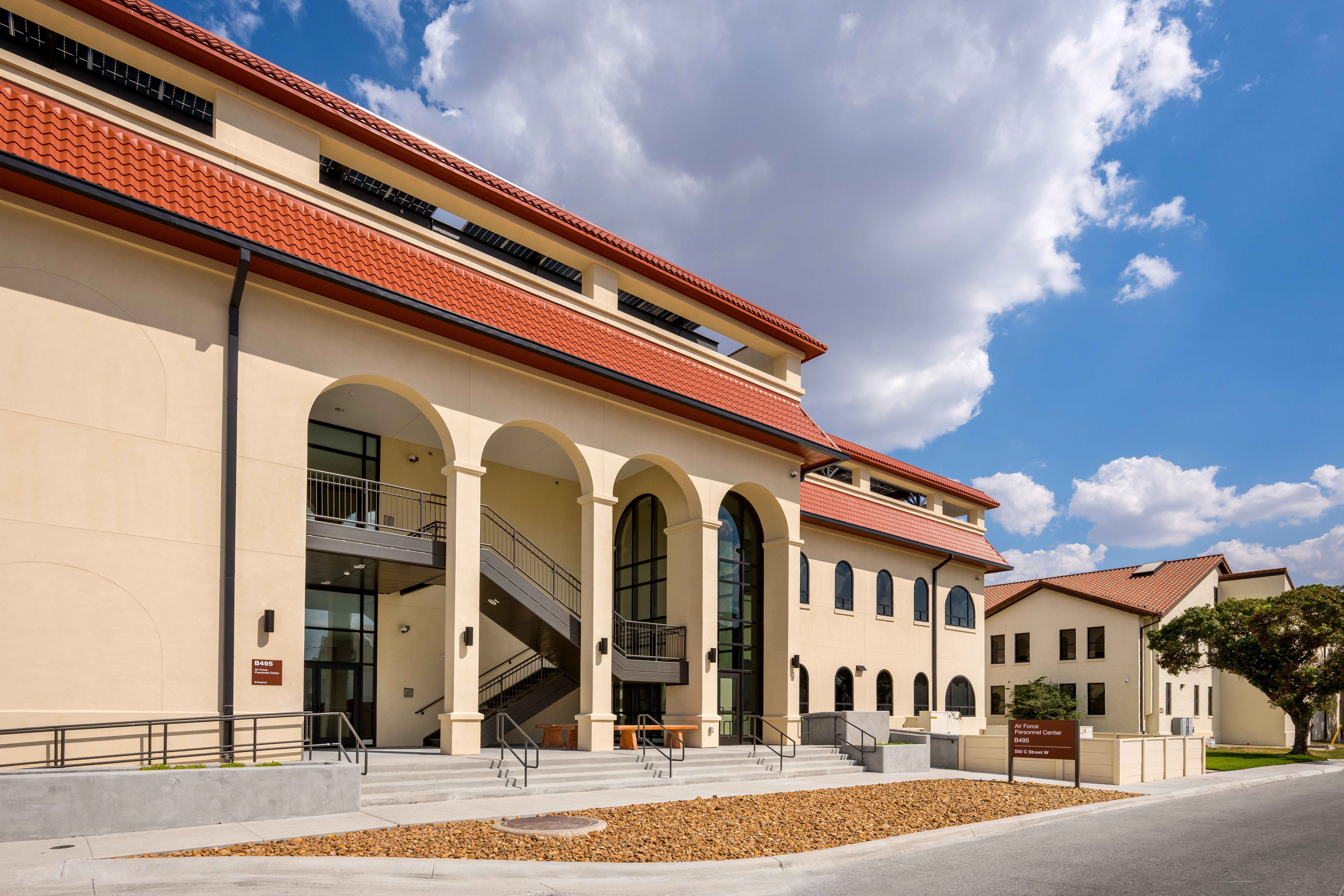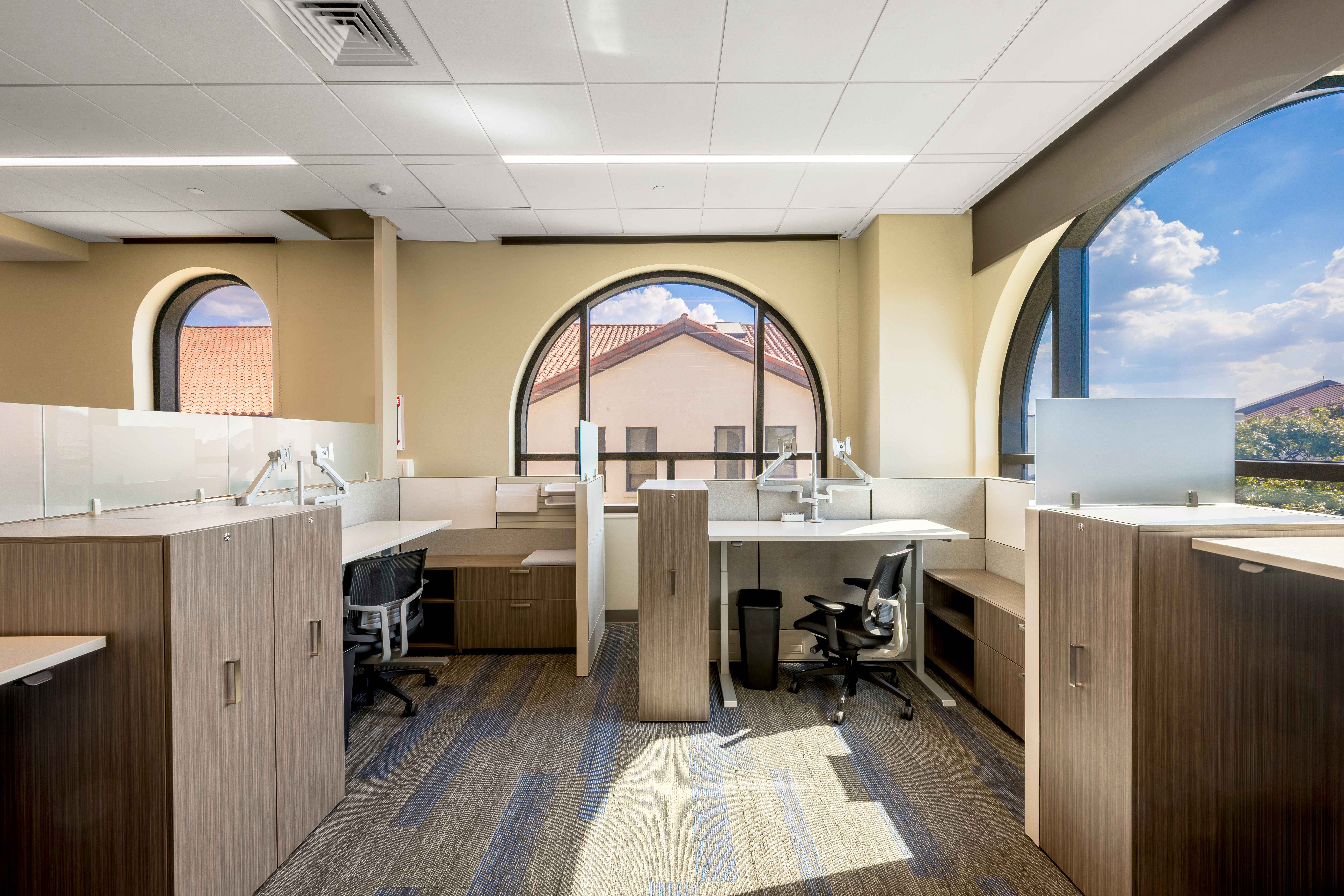The New B-Wing Administration Building
The Air Force Personnel Center (AFPC) on Randolph Air Force Base (AFB) in San Antonio, TX, includes five wings (A through E), each a separate building to house most of AFPC's 2,700 Airmen who work to develop and deliver innovative, customer-focused support solutions to commanders, Airmen and families. The original Administration Building or “B-Wing” from the 1960s was demolished in 2015 due to significant deficiencies, with personnel and functions temporarily relocated into the other buildings throughout the campus. The United States Army Corps of Engineers (USACE) was looking for partners who could design and build a new B-Wing Administration Building that would house more than 200 AFPC programs and serve as a critical operational hub for Randolph AFB.

When the Bodwé team was first contracted for work at Randolph AFB in 2018, our role was modest: develop conceptual planning documents and deliver a report that USACE could use to secure funding for a new B-Wing Administration Building. The finished product has evolved into the first net-zero federal facility on an Air Force base and introduces a new benchmark for sustainable design while showcasing Bodwé’s ability to lead complex, high-impact projects from beginning to end.
With construction now complete, the team is excited to attend the ribbon cutting and see the building being used to its full potential. As we reflect on the journey of the B-Wing Administration Building, this project stands out as a testament to our client relationships, collaboration and adaptability in times of change, and the commitment we have to sustainable design.
Vision and Design Intent
The initial team consisted of just two people: former Project Manager, Sara Tripp, AIA, LEED AP and Project Coordinator, Shane Cromwell, Associate AIA. The relationships and trust they built early on with both USACE and the end users from the Air Force ultimately led to Seven Generations A+E, a Bodwé company, being awarded the design contract. “To my understanding, it’s very rare for a firm that does the budgeting process to also get the design contract,” said Cromwell. “But Sara and I had really good relationships with the end user and the client. They advocated for us to win the design award.”

Situated within a designated historic district, the building design had to align with the base’s Spanish Revival architecture. Balancing efficiency and preservation, the team used insulated concrete forms (ICF) to create an airtight, load-bearing wall system that was finished with stucco to match the base’s surrounding historic structures. Using ICFs was a learning opportunity for the design team, and it was a major component of increasing the building’s energy efficiency and making the mechanical systems work more effectively.
“It’s not a system a lot of contractors or even clients are familiar with,” said Lead Designer, Shawn Lettow, Associate AIA. “But it offers outstanding thermal performance and resilience, and that’s what you want in a high-performance federal building.”
The site itself posed additional physical constraints. Nestled between existing buildings, the footprint required careful coordination of access points and circulation. The final layout features a central “spine” corridor with open office space on either side, maximizing daylight and connectivity. Interior design played a key role in the building’s success. Senior Interior Designer Stephanie Sokolowski, NCIDQ, CHID, LEED GA, IIDA, explains how the standardization of furniture layouts based on job roles allowed the team to fit all of the AFPC programs into the space without compromising comfort or functionality.
“It was a space planning puzzle, but the different tiers of standardized furniture layouts helped us accommodate more people,” said Sokolowski. “Instead of creating private offices, we used a furniture solution that was more flexible and took up less space.”

Safety and security were other critical considerations throughout the design process. The building includes a secure conference room designed for national-level decision making, with dedicated access and privacy features such as switchable glass for the conference room windows. One of the most technically unique features is the use of horizontal fire shutters, which allow for the open atrium spaces between the first and second floors while maintaining code compliance for smoke and fire suppression.
“If there was a fire, these shutters would roll out horizontally to seal off the opening between the floors,” said Lettow. “This allowed us to preserve the open spine of the building and maintain natural light while keeping the building and its occupants safe.”
Delivering a Net-Zero Building
B-Wing’s most significant achievement is its net-zero energy performance. The decision to pursue net-zero came mid-design and required the team to think quickly to meet this new goal. Working closely with USACE engineers and sustainability consultants, the Bodwé team shifted the B-Wing design to meet the Living Building Challenge’s Zero Energy Certification.
At the core of the design was, of course, the high-performance envelope built with ICFs to provide continuous insulation and reduce heating and cooling demands. An extensive, high-efficiency solar array was strategically deployed and carefully concealed so that it covered most of the building’s roof surface area, thereby maximizing energy generation throughout the year, while maintaining the Spanish Revival aesthetic when viewed from the ground. The 550-kW photovoltaic solar panels generate enough renewable energy to offset the building’s annual consumption, and mechanical systems were designed to maximize efficiency.

Since 2010, Randolph AFB has operated on a centralized utility loop, with thermal energy storage, or TES, units located around the campus to meet air-conditioning needs in each building without having to maintain and power individual chillers. Integrating a net-zero building into that system means other buildings will benefit from the new B-Wing, which is capable of producing enough of its own energy and heating and cooling load that it can feed back into the utility loop.
Being able to go net-zero so late in the design development phase was made possible by the proactive budgeting and cost estimation done during the initial planning. Tripp attributes the project being under budget to the expertise of EudaCorp, a small minority owned business specializing in cost estimating, scheduling, and value management services. “I’m grateful to Claude Eudaric and the EudaCorp team because their work early on allowed us to add the solar panels and water systems late in the game,” said Tripp. “At one point, USACE was concerned that something critical was missing because of how much budget we had left, but we had simply planned for the unexpected.”
Adapting Through a Global Pandemic
The Bodwé team was deep in design development when the COVID-19 pandemic began. In-person meetings and site visits were abruptly replaced by remote collaboration. The team quickly adapted, leveraging Microsoft Teams to keep the project moving forward. Daily virtual working sessions became the norm, with team members remaining connected for extended hours to resolve design challenges. “Shawn and I would stay on a call all day,” said Cromwell. “We’d bounce ideas off each other in real time. It was like we were still in the same room.”
The use of technology and virtual workspaces helped minimize delays in the project schedule while strengthening the team’s remote collaboration capabilities, which have since become standard practice as we work together across four office locations with remote team members and partner firms nationwide. Still, constructing a building post-COVID brought additional challenges, such as increased costs for materials and labor. Construction Administration Manager Jennifer Yard, AIA explains how the biggest challenge during construction was one the team hadn’t accounted for.
“We had to add a fire pump room after the fire flow test numbers came back lower than what was tested originally back in 2019,” said Yard. “It was a bit of a challenge, figuring out where we could add space for the fire pump room. It all worked out in the end, but that took several months to understand how it would be integrated into the building and how it impacted the design.”

A Lasting Legacy
From its beginning as a week-long planning exercise to its completion as the first ever net-zero federal facility on an Air Force Base, the B-Wing Administration Building sets a new standard for sustainable federal facilities and demonstrates the Bodwé team’s capacity for leading complex, high-impact projects from concept through completion.
“This project showed we’re more than just draftsmen for the government,” said Cromwell. “We can lead design, push for sustainability, and build the world we want.”

The trusted relationships our team built from the beginning laid the foundation for a collaborative and efficient design process, ultimately setting up the Bodwé team for continued work with USACE delivering high-performance facilities.
“The relationships and reputation we built with USACE through the B-Wing project really opened doors for our team,” said Bodwé’s Chief Operating Officer, Jeremy Berg, AIA, NCIDQ, LEED AP BD+C. “That collaboration and trust have led to additional opportunities to support USACE projects, and that’s something we’re very proud of.”














